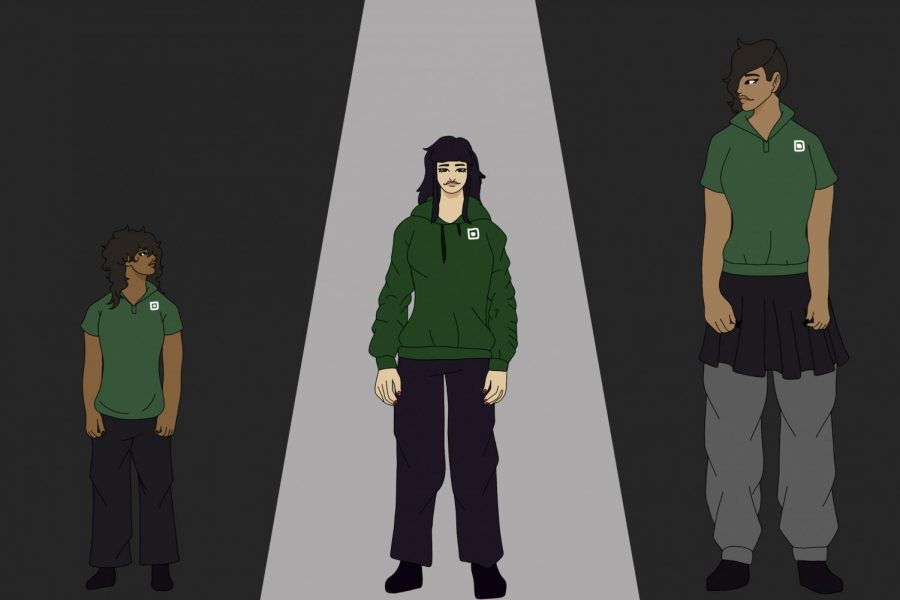Heightism affects athletics, media portrayal, romantic relationships in contemporary society
Photo credit: Molly Solowitz
This illustration depicts the effects and various stages of heightism that members of the Archer community and beyond can experience. Additionally, this image demonstrates the greater effect that heightism has within our society, considering it doesn’t only affect one group or type of people. This illustration was created by graphic design artist and sophomore Molly Solowitz.
In our society, the effects of racism, sexism, anti-Semitism, homophobia, transphobia and xenophobia have become prevalent topics of discussion, whether that be in Twitter threads or break room conversations. However, according to 5 foot 11 sophomore Shaun Milton, one form of discrimination is often “overlooked” and “pushed aside”: heightism.
While the concept of body-shaming usually connotes the physical shaming of one’s body figure or weight, another aspect of body-related prejudice that is often forgotten or left out within this topic is heightism or the discrimination of someone on the basis of their height. Although not as institutionalized as other forms of discrimination in our society today, citizens are aware of the social advantages and disadvantages that come with height.
Although heightism is seen as a prevalent topic of discussion to the members of the Archer community interviewed, it isn’t necessarily perceived that way in the greater Los Angeles population or society.
Considering there are various ways to body-shame, heightism appears in multiple aspects of life, whether that be dating, sports or media portrayal. According to a research experiment conducted at Baylor University, height has either advantaged or disadvantaged both men and women in the workplace, as well as in romantic relationships.
“It says 90 percent of company chief executives are above average height; job recruiters choose the taller man 72 percent of the time when choosing between men of comparable backgrounds and skills; promotions come faster to the taller man; women find taller men ‘significantly more attractive,'” author Andrea Cecil wrote.
From an athletics standpoint, height is always something that is seen as beneficial and helpful for not only players but coaches as well, according to Milton.
“Participating in a sport where everyone is tall and my height is considered to be short, I have often felt like the odd man out,” sophomore and year-round volleyball player Lily Miro said.
Miro, a 5 foot 5 libero, plays for Archer’s varsity team during the summer and fall seasons and continues her play for the remainder of the year with her club team.
Echoing Miro’s statements, 4 foot 11 sophomore Hannah Stein said she constantly had to quit or switch between various sports due to her height.
“I tried to run track, but my legs weren’t really long enough to get those strides,” Stein said.
Although Stein attempted to play volleyball, track, swim and basketball, she ended up quitting these sports in middle school with the intention of discovering new passions in high school that didn’t solely depend on her size, stature or athletic inclination.
On the contrary, Milton views her taller stature as a “huge advantage” in various sports but also a subject of teasing and bullying.
“A lot of people when I was younger used to make fun of me for my height and lankiness,” Milton said.
Along with the physical displays of heightism that Milton experienced, she said the media also played a “key role” in the representation of both tall and short girls.
“The media chooses to portray people who are tall as if they are giants or Amazonians who only play sports in their free time,” Milton said.
Aside from sports, another aspect of life that enforces “discrimination” for specifically shorter girls in our society today is media and television portrayal, according to Miro.
While Milton feels that tall people are misrepresented in media, Miro said that shorter girls struggle to see themselves represented at all.
“In the media, there is this representation of models and how you have to be tall in order to be pretty,” Miro said. “There are young girls who are looking at social media and seeing all of these models and influencers, which can be extremely detrimental to their mental health and how they see their body.”
Upper school history teacher Meg Shirk, who is 5 foot 10, said she has been able to benefit from societal beauty standards.
“When you think of high-runway fashion, those girls and women tend to be 5 foot 10, so I think because I’m roughly that size, I benefit from that being the norm,” Shirk said. “These beauty standards are telling me that it’s good to be 5 foot 9 or 5 foot 10, considering that’s what is seen as beautiful nowadays.”
According to an email interview, Victoria Garrick, a 5 foot 9 former Division I athlete at the University of Southern California, witnessed her former teammates and friends experience heightism many times, specifically pertaining to how height shaped each of their roles as Division I volleyball players.
“Being a volleyball player, I have spent years surrounded by women who are much taller than the average girl. To think of one of those players or myself being made fun of or discriminated against for our height is something that upsets me,” Garrick said. “Since the sport of volleyball is known for having tall players who need to reach and swing over a net, I feel like heightism might be more present in [my] sport than it would for perhaps a soccer team.”
On a non-sports related note, Garrick also said she experienced heightism in her everyday life outside of the volleyball world, which impacted both her tall and shorter acquaintances.
“People make jokes about my best friend for not being tall enough to ride the roller coasters or say that she should shop in the kids’ section. While they think this is funny, it definitely can be harmful to someone’s feelings,” Garrick said in an email interview. “I have heard many men say that me and my friends are too tall to date. For some reason, this passes as a casual talking point amongst many dating conversations when, really, it is heightism.”
Outside of educational institutions and sports arenas, height plays yet another role in the world of dating, further prompting people to either accept or decline romantic partners solely due to their given height.
“For women specifically, height comes into play with dating,” Shirk said. “I think of comments like, ‘I’d only date a guy who’s taller than me,’ which causes me to reflect back on my own dating life because I definitely wouldn’t have been as excited to go on a date with someone who was shorter than me.”
According to a recent study completed by Rob Henderson, a Ph.D. student from the University of Cambridge, approximately 13.5% of men prefer to only date women shorter than them, while 48.9% of women only prefer to date men who are taller than them.
Also examining current beauty standards and norms further, Stein commented on how heavily height is “judged” and “enforced” when deciding upon one’s future partner.
“With guys especially, height is seen as a good quality that everyone wants,” Stein said.
Although a foot apart from one another, Milton reinforced the comments made by Stein, emphasizing how girls taller than the average height are often “less sought out” or “pushed aside.”
“For some reason, not a lot of guys go for tall girls,” Milton said. “To them, the perfect height for a girlfriend would be around 5 foot 5 or 5 foot 6, and anyone who exceeds that limit isn’t in the picture anymore.”
Looking at these discrepancies through a media and film lens, Garrick said that media and television executives attempt to conform to these height-based stereotypes in “obvious” ways through their advertisements and reality shows.
“I do think that the media does portray their idea of normalcy when it comes to height. For example, things like a groom taller than a bride or putting people like Ryan Seacrest on boxes behind scenes so he can appear taller or as tall as his female cohort,” Garrick wrote. “This suggests that it is not okay for men to be shorter than women and that women should feel uncomfortable if they are taller than men.”
Although the topic of heightism isn’t institutionalized within our society or seen as a “relevant” or “well-known” topic, according to Milton, many seem to forget this concept is just as much a part of body-shaming as weight discrimination. It should be taken seriously within our society, rather than being simply “pushed aside,” Milton said.
Milton among others emphasized the importance and significance that height has played in their lives as a whole. Although hard to swallow at first, these hurtful height-based experiences, both dealt with by tall and short people alike, have helped contribute to more confidence and self-assurance among all interviewed.
“I always wanted to be the tallest one in the class when I was younger, and I remember being really prideful in how tall I was,” Milton said. “But because of how prideful I was, I think a lot of people tried to knock me down for that reason, which was why I was always bullied and teased as a kid. But nowadays, I don’t really care what others say. I love being tall because it makes me ‘me.'”

Vaughan Anoa'i joined the Oracle as a staff reporter in 2019 and became the News Editor in 2020. In 2021, she became the Editor in Chief. She loves playing...










Connor Tribou • Jan 12, 2021 at 5:50 am
I had to do a project about an injustice for school, so i chose heightism. This article is helping out a lot, for my research.
Beth Gold • May 23, 2020 at 8:36 am
Great job Vaughan! This is a well researched and balanced article on a topic that doesn’t get much discussion. I can see why you were so excited to explore this topic!
Chris Hamre • May 13, 2020 at 7:19 am
Thanks for writing this article Vaughan! This form of discrimination, tho widely practiced, is not frowned upon as it should be. As a shorter male -5’3″ – I have experienced this way too often! From being openly disrespected by my supervisors(and receiving no recourse) to having my stature mocked in the Orange County Register way back in 1985 and many more instances that have happened to me personally and to other shorter people in general. It is just disgusting!
Seth Ulinski • May 12, 2020 at 6:38 am
A thought-provoking write-up on a topic that doesn’t get a lot of attention, despite being one of the most prevalent forms of discrimination in society.
As a male below average height, it is interesting to read about heightism through a female POV. Thanks for shining a light, Vaughan.
Seth Ulinski
Author, Amazing Heights